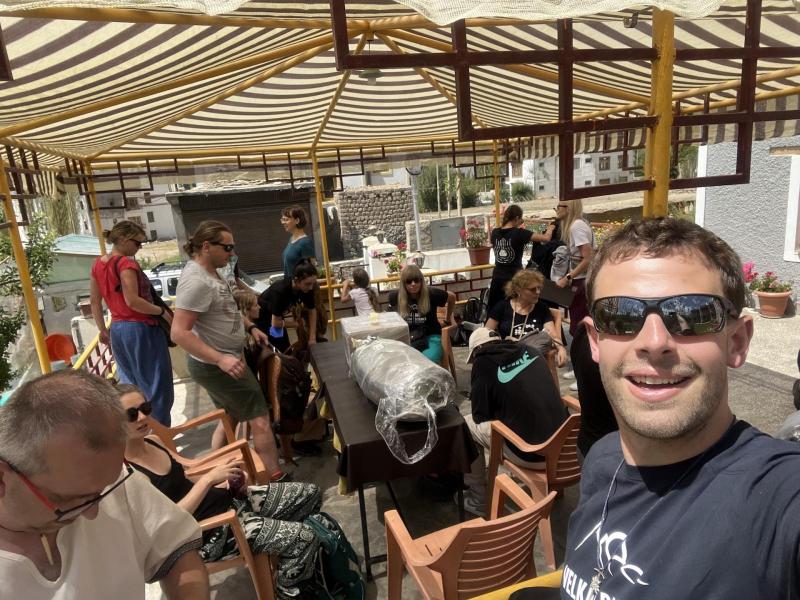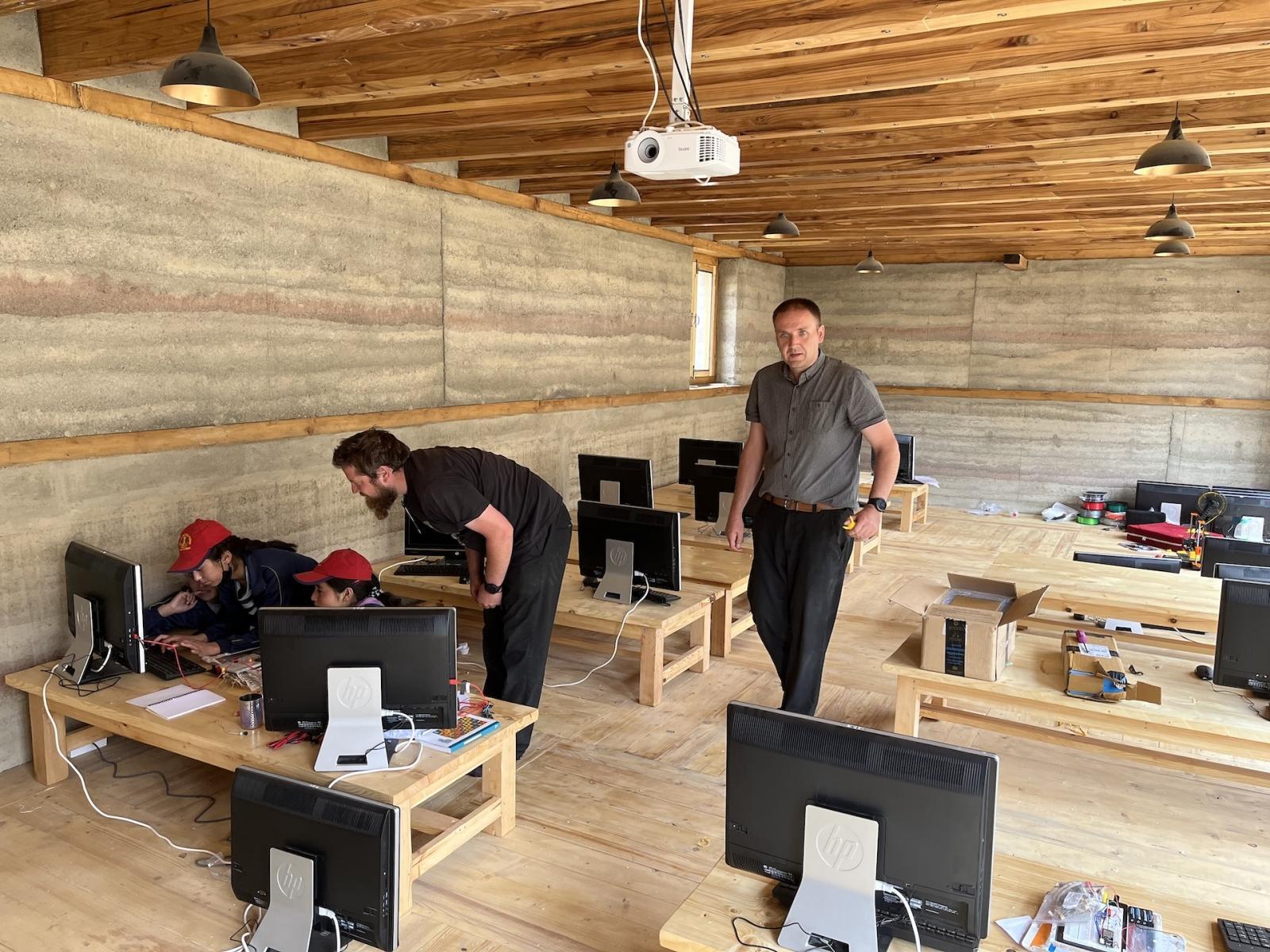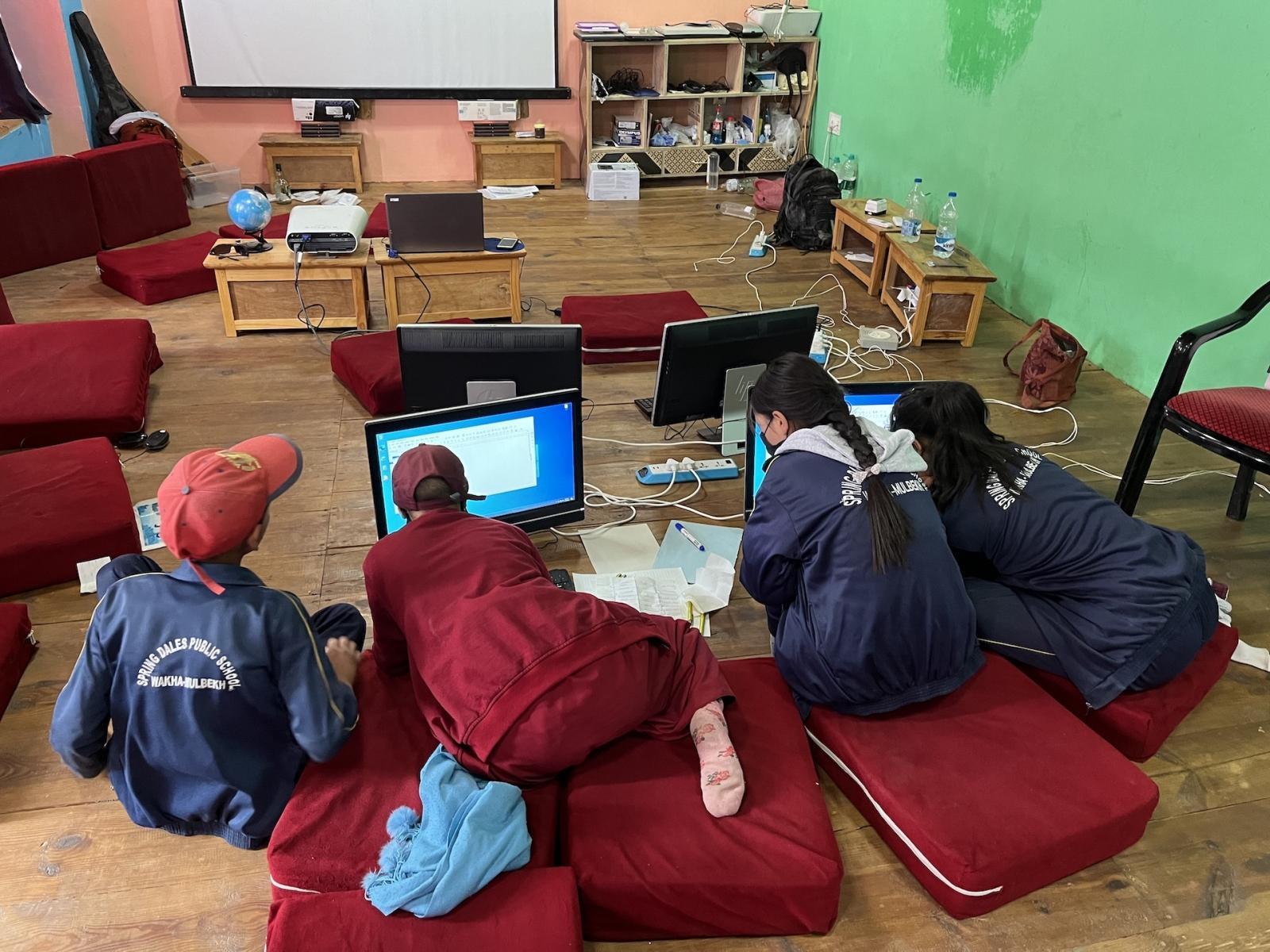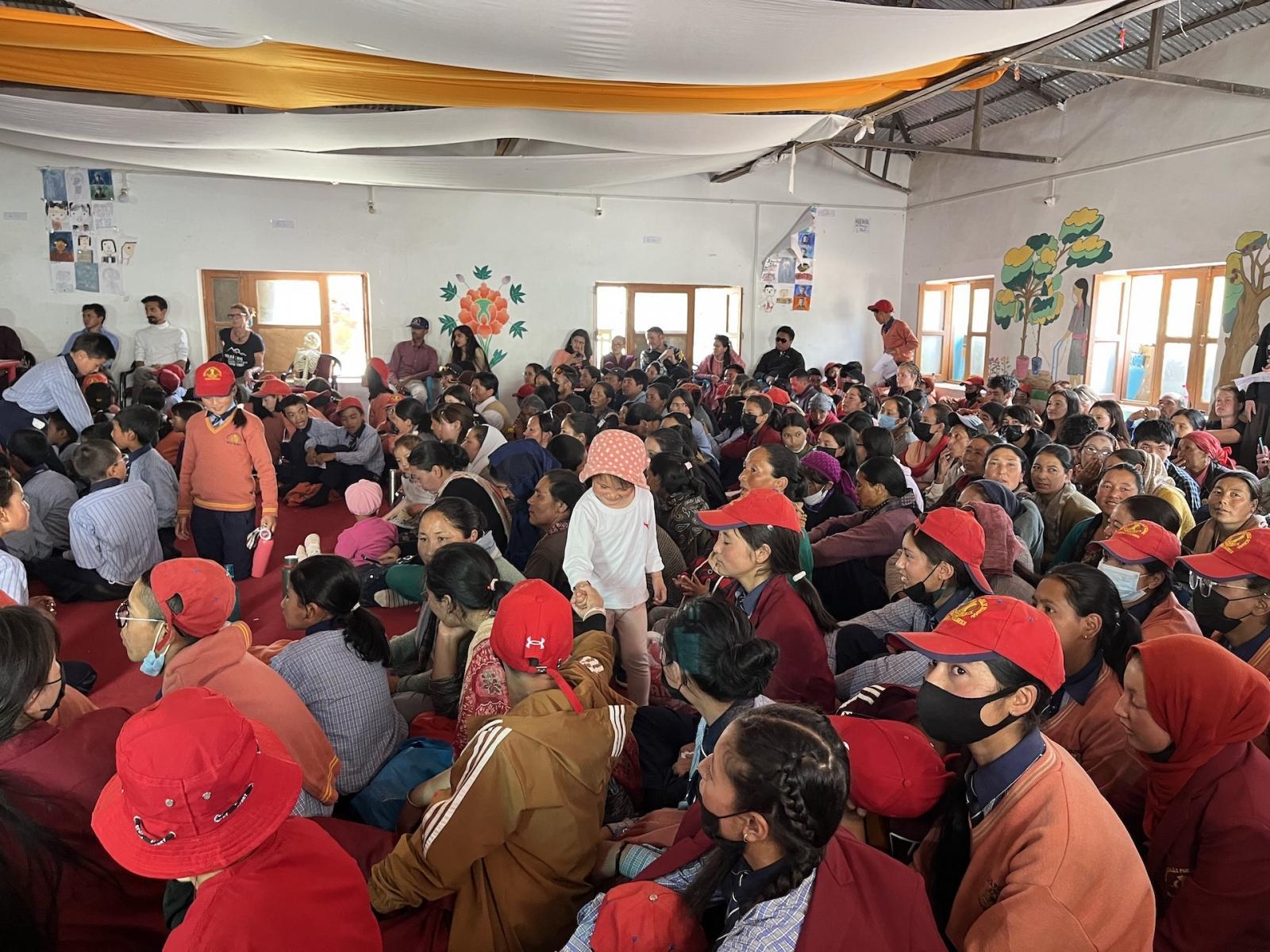People
“I expected chaos, dirt and mess,“ says a researcher from CEITEC BUT who taught children in the Himalayas

He turned off the news from Europe for a month and went to help as a volunteer of Brontosaurus in the Himalayas in a small village in Mulbekh, India. He came back refreshed, and with the feeling that he had taught the local students, who at first did not know how to convert centimetres into metres, to model arbitrary shapes on the computer and materialise them using a 3D printer. Researcher Adam Ligocki from CEITEC BUT participated in the expedition for the first time and would recommend it to everyone, even families with children.
How did you hear about the opportunity to volunteer as a teacher in the Himalayas?
About three years ago, e-mails started coming to CEITEC from Jirka Sázel, the head of the Brontosaurus in the Himalayas organization, and I thought that something like this was needed. But I always found some excuse not to sign up. Then there was a hiatus because of the pandemic, and this January the email came again, so I thought, now I have to. I wrote an application form, a kind of motivation letter, describing what makes a person take his 40,000 and pay to be somewhere in the mountains suffering, sick, with all his mucous membranes dried up, and why he wants to go there to teach children he doesn't know. And what made this year even more interesting from CEITEC's point of view was that it was focused on science. So out of the 30 people who went there to teach, about 25 were attached to universities and research institutions. That was also a big motivation.
Can you tell us your reasons for wanting to go on the expedition?
I will mention two levels. Firstly, I wanted to get to know the local culture because I love to travel and I have never been to the Himalayas in Asia. And it's something other than just lying by the sea or climbing mountains. It also connects to something useful. Children can benefit from this. So I wanted to see if I would be able to come to the children from the other side of the world and give them something. And the second dimension was the mountains. I've been walking for a long time and I thought, Himalayas, it's impossible to go higher, so let's go to the Himalayas.
How did you prepare for the expedition? It was your first time, did you know what to expect?
There have been several expeditions to Little Tibet before us, so from the organizational point of view Brontosaurus in the Himalayas have it pretty well covered. Before the expedition, there are two mandatory meetings, when the registrants will meet from Friday to Sunday for a team building and at the same time get the necessary information – what is expected of us, what it will look like, what to prepare for, what to count on and what to bring. So you don't go there with the idea of going completely into the unknown. You can get a pretty good idea, look at videos from previous years, etc. Accordingly, one could get ready and mentally prepare what to give to the children. It would probably be foolish to think that 30 Czechs will come there for 14 days and change the Indian education system – that is not the goal. The aim was, and hopefully succeeded at least a little, to take the children out of their daily routine for two weeks. What are we going to say, it is a small village in the mountains, where there is not much money, the teachers go there more out of compulsion than because they are passionate, with a few exceptions. So we wanted to get them excited and plant a seed of interest in them, and whether that seed will sprout or wither is something we can control very little.
When you arrived at the place, did your vision come true? What was the clash with reality?
I was expecting stink, dirt, mess, chaos. Arriving in Delhi was like that, that's how I imagine India. But we didn't actually stop there, we went to Leh, the capital of Ladakh, which is the most northern tip of India. The locals live mainly from herding and tourism, so they are prepared for tourists. It's safe there, even women don't have to be afraid. There was chaos, but there was no stink or ugly mess. And time may not be an issue at all. When you make an appointment for an hour, the appointment doesn't happen at the agreed time, just some time during the day. Even our taxi arrived two hours late. We accepted it and I personally tuned into it very quickly. So, for example, we officially invited parents to school at the tenth hour. At 11 the first parents arrived and at noon we could start the program.
Did you fly in and head straight to school?
The first days we acclimatized in Leh, it looked quite similar to the scenery in the famous movie Seven Years in Tibet. Only the electricity was already there, so there were wires running through the air. And after four days we were moving to Mulbekh. I imagined it to be medieval, with people barely speaking English and horse-drawn carriages everywhere, but everything was much better than I expected. Cars drive there, there is a signal, they have relatively stable electricity, I mean, it only goes out once a day for five minutes, but otherwise it works quite well. Even if they only have it for lighting. They also have a 4G network, for Rs 500 (CZK 150) per month they have 500 free minutes, 500 SMS and 1.5 GB of data every day. And the internet went perfectly. There are no computers, but everyone has a smartphone in their pocket and they're on Instagram and TikTok. Overall, the place felt like I was visiting my grandparents in the Beskydy Mountains. It's like a 1960s Czech village with only the internet.

How did the locals welcome you?
Because we have been coming to Mulbekh for 12 years, people know us there and welcome us and know that if Czechs come there again during the holidays, it will be great. The kids are happy about it, the locals are excited, they are happy to see us. You walk the streets there, they invite you home for coffee, tea, rice.
Can you describe more about the mentality of the people? What perhaps surprised you as a European.
They are not innovative. They have their cow or a couple of goats, and that's enough for them. They live the same every year, they don't improve anything. There was one thing that really bothered me. It's very cold in Mulbekh, it's -25°C during the winter, and they are not able to insulate their houses. They build them out of unfired bricks, basically they take some mud and dry it into a 20x20 cm cube. Because it's a dense material, it freezes in a day. At home, they have -10°C and heat only one room. If they made the brick bigger and with holes, or built a double wall like they do in Ireland, and used moss/straw sandwiched between two layers of brick, they'd have insulated the buildings, and they just aren't capable of that. Not even in the capital, where, for example, they are building new hotels. At most they'll add a little more cement, like a big innovation. I guess they don't mind the cold at home.
What did you teach the kids at school?
I had two parts. The dominant one was a 3D printer, which my colleague Václav Fiala managed to get from Josef Průša as a gift for the school. Also, thanks to Minister Martin Bax, about 20 computers flew with us. Which worked out great, because after about 4 years a new school building with four classrooms – IT, biology, physics and chemistry laboratories – was completed in Mulbekh. We went to open the building and at the same time we brought equipment, such as the computers that now serve as the main equipment of the IT classroom. So my colleague and I set up and put the printer into operation, installed the software on the computer, and then spent 14 days teaching the kids how the printer works – how to model something on the computer, how to print it out. Of course, we had a lot of things in mind to make it better, but in the first lesson we realized that nothing would come of it, that we had to redo the plan.
For what?
The local children are clever, they are normal children, but they have the terrible problem that they are victims of the Indian education system, which suppresses any thinking, any creativity. Everything is just memorized, and there is a great effort to recognize authority. We came to the first lesson and the kids were afraid to talk to us. And they were about 14 years old. So for the first two days we were breaking down the barrier. In addition, the children were not proficient in logic and mathematics, which is what modelling requires, so we also encountered that. For example, they didn't know how to transfer units, but even that broke down after about a week and after 14 days they had to do the final project. This consisted in modelling their stupa and three of the four teams did it perfectly. They even tried some embellishment, but it was no longer symmetrical, but we still left with the feeling that we had succeeded. Then the question is whether it will last, but we have been in contact with them, so hopefully it will continue. We also tried to get the local teachers excited about it.

What potential does a 3D printer have for them?
I would see about three levels. Firstly, to create different teaching aids or models. Maybe they can print organs, gears, physics tools, etc. Secondly, to develop their creativity, when they think of something, like a mobile phone holder or whatever, they can sit down at the computer and model it. And thirdly, it was our secret plan that the children could print some Buddhas or stupas and sell them to the tourists who pass through the village from time to time. And not for 50 rupees, but 500 rupees at least, which is already a day's salary for a worker and actually almost a teacher. For ours it comes out to less than two hundred crowns.
A worker has almost as much as a teacher?
There is a huge gap between public and private education. It's not like ours, but the opposite. The public sector has far more money and the private sector is suffering. And the school in Mulbekh where I taught is private. There is a state one a little further on, but that is Muslim and Mulbekh is Buddhist. But the religions actually live in reasonable coexistence there, or so it seemed to me. However, a teacher in the private sector is underpaid, earning about 17,000 rupees (CZK 6,000) a month. Mostly they're there out of compulsion or temporarily until they find something better. If they were teaching in a public school, they would have three to four times more.
You said you were doing something else besides 3D printing...
Yes, I was still a kind of auxiliary force when my colleague Radka Kellner and I brought the weather station there. She was teaching them the basics of meteorology and I was setting up the weather station. We want to connect it to Wi-Fi, which hasn't happened locally, but when the locals can do it, we should have data from their weather station.
How many classes did you teach and how large were they?
We had it scattered, there are about 150 children in the school divided into 10 classes. We had upperclassmen classes and still split in half. We always taught a maximum of ten children and two hours a day. Basically, we had 4 tutorials for 9th and 10th grade. 3D printer, meteorology, chemistry/biology and a rocket to Mars. Half the class was in meteorology and the other half was in 3D printing and then they switched.
You talked about the initial barrier between you and the students. When you managed to break it, how were the students compared to the Czech ones?
I also have some experience with teaching Czech children of the same or similar age (15 years old). In general I would say they are more grateful, without wanting to put down Czech students. I think it's the amount of impulses and stimuli that come at Czech children from different directions, they are probably fed up with it. They are harder to impress, whereas the children in Mulbekh are immaculate by this. It takes only a little to put a smile on their lips. Plus, they thank you for everything.
Did you manage to give them everything you prepared?
We had prepared the teaching program precisely. It had ten hours in total, but we prepared for about a hundred hours or more. In reality, we used about 20% of the original plan. If I were to go there again, I could only imagine some minimal preparation.
Do you think they will continue to use the 3D printer after you leave? Or they'll lock it in a closet and come back next year when the Czechs arrive.
We hope the teachers will take it up, we have tried to teach and enthuse them as well. But, what are we going to say, 25 Czech scientists ran there, each of them forged in their own field. They brought all sorts of gadgets, and the local teachers are perfectly normal people with normal brain capacity. They probably can't take it all in and apply it to teaching, but there was an effort to motivate them. However, I know from past years that most of them have been put away in the closet. Let's see, I'll write to them in a month and find out what's up.
Could you say what the expedition gave you in return?
I found peace of mind there, I calmed down. Even though I had to get up in the morning and run around the kids all day, it was basically a full time job, but I came back mentally refreshed. It was the first time I left Europe and I didn't know what was happening in Europe for a month. Otherwise, I was used to watching the news from Ukraine every day, ČT24 in the evenings and reading the news and Twitter. There I forced myself not to look at it and I didn't miss it at all. In addition, I brought back knowledge about the local culture that pleasantly surprised me. I would definitely highly recommend this place to everyone. For me, it was the best leave I've ever been on.
(CEITEC BUT)
A lack of hay for horses inspired Joes Jančář to create a smart nutrition for plants
Breakthrough “muscle” actuator: CEITEC BUT researchers receive prestigious EU grant as the only Czech coordinators
Brno is an oasis of peace for me, I feel relaxed here, says Chinese doctoral student Xia
CEITEC Scientists Developed Long-Lasting Flexible Batteries with Shape-Memory
Who is Martin Pumera, one of the most cited scientists in the world?